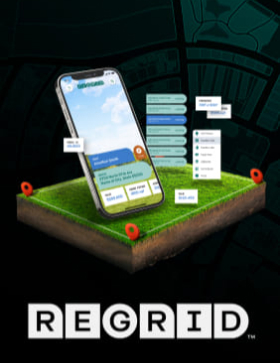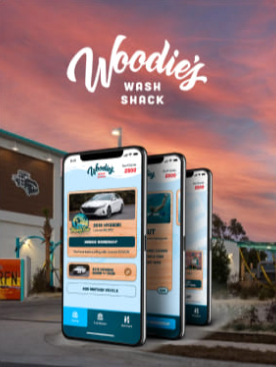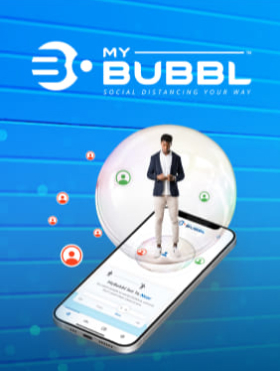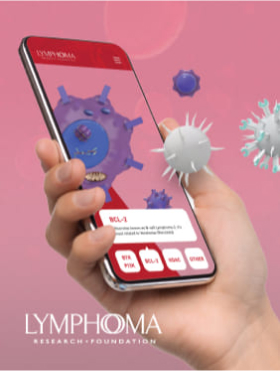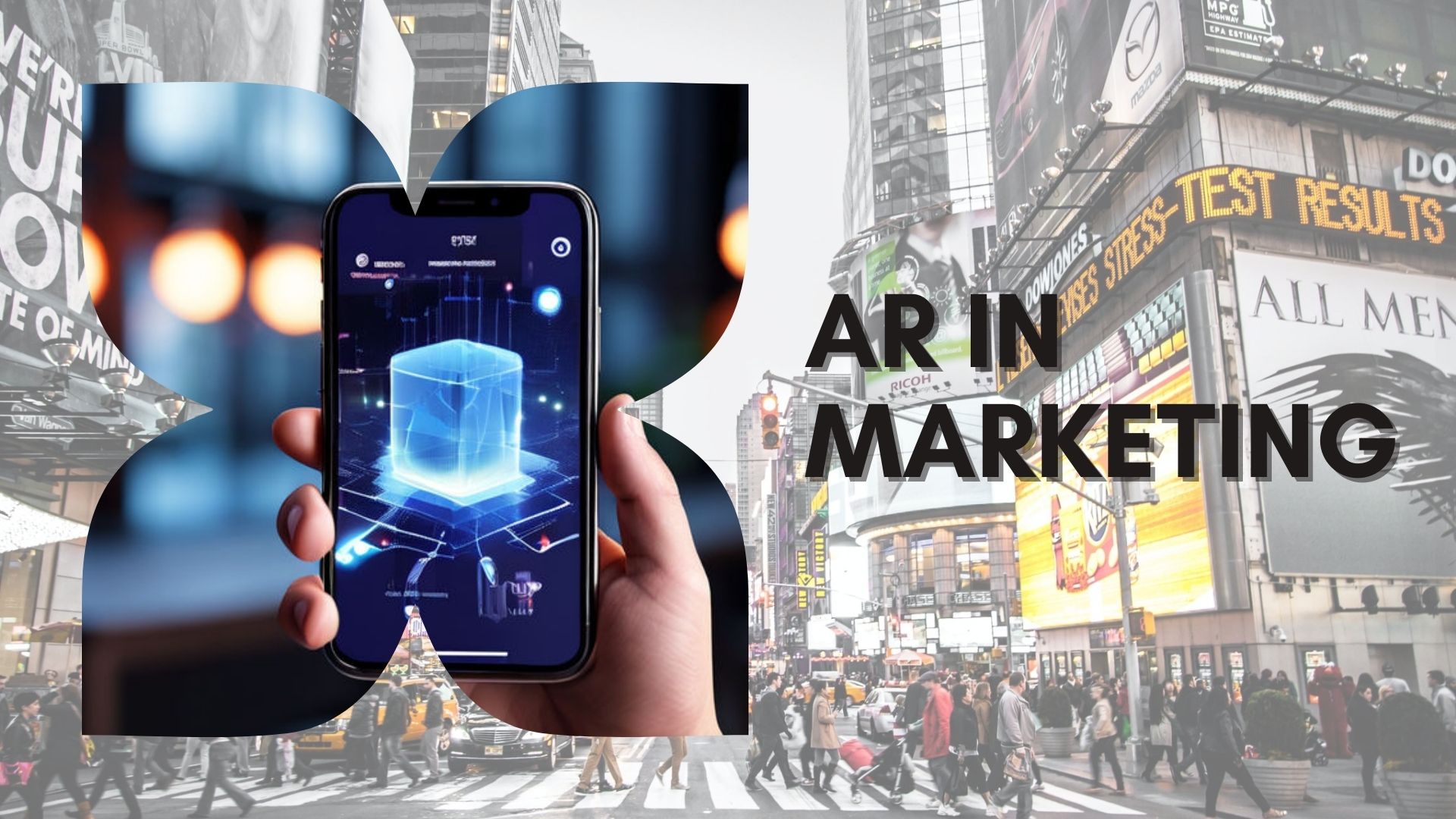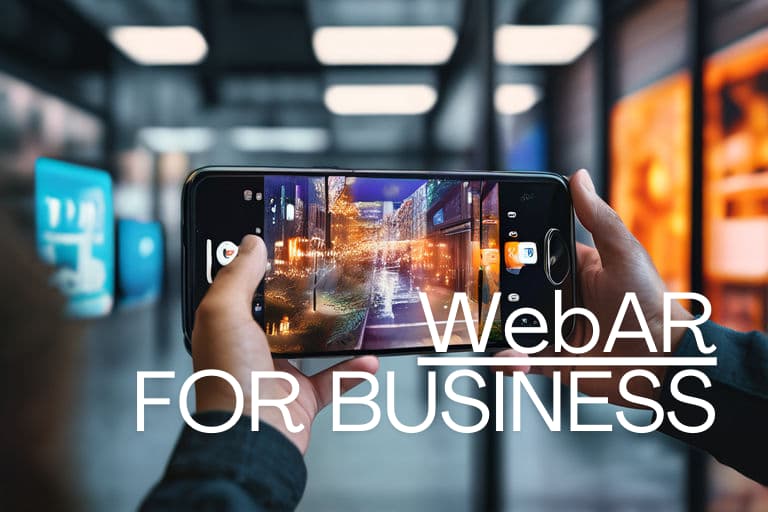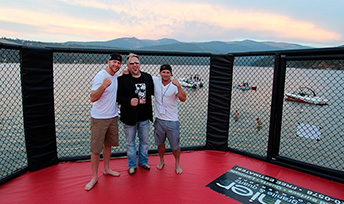
“I can totally understand what you’re feeling.”
It’s almost as if sales reps everywhere expect this generic line to magically crack the safe, giving them access to unending budgets.
“Those guys,” they say, “they don’t really get you — but it’s your lucky day! We do!”
Heard it before? We all have. Now, before I get too into the narrative of how I, the CEO of the Pacific Northwest’s leading mobile digital agency, running a squadron of elite programmers, somehow found myself locked in the middle of a cage match — and, of course, the “Why?!” of it all — it will be helpful for you to have just a bit of background information on me.
Bucking Tough
I grew up part of a very low income family, in a farm community on the east side of Washington state. I had a single pair of pants that would get patched until the next year, complimented by used shoes from the local secondhand (or third, depending on the pants) store. When I was seven years old, there was a tragedy in our family and I swore that my daughters, if I had them someday, would always be tough. I didn’t understand things fully at the time, but the childhood that I experienced made me an angry kid. Among other character traits, the first thing I would do if someone laughed or made fun of me was fight. Although it would likely make a better story, I can’t say that I had never been in a brawl — but the cage is different.
In Cheney, Washington, when you’re 11 years old, you start bucking hay bales into trucks for summer work. I needed more, so by age 12 I was working full-time on a ranch, cleaning stalls, training horses, taking care of the fields and doing anything else I could. Aside from a healthy work ethic, by age 15, I also had earned a fairly healthy physique. This undoubtedly made my freshmen year of high school a bit easier, particularly with the (ahem) ladies. At times, the result of this newfound confidence when combined with ‘passion’ was, as history has proven for centuries, a few fights. Actually, a lot of them. These fights were brutal, farm-kid fights that happened exactly like any untrained fights happen. The strongest (usually) win. The recipe: Very little technique (if any) and a whole lot of new-found testosterone.
Adrenaline Therapy
But why in the world would any sane person want to participate in an MMA cage match at age 40 — let alone, the first one of their entire life? I’m going to try to answer this for both of us. As far as my hobbies go, they have broken me over the years. I race cars, ride motorcycles, jump out of planes, wakeboard, snowboard — if it is fast and has some element of danger or uncertainty, I’ll probably be interested. I have had more concussions than I can count (get it?), found my way through two windshields, totaled every sport bike I have ever owned (I have never had the pleasure of selling one of my sport bikes), and even managed to break my neck and tailbone in a freak skydiving accident. It may seem extreme or “too much,” but the adrenaline is an outlet. While my physical body has been taking a beating, I have also spent the last 20 years calming the angry kid down.
So, you get the picture. Let’s bump to 2012. I am a 38 year old husband and father of four beautiful kids — three of my kids still at home. My oldest daughter is 13, my youngest daughter is 10 and my “mini me” is a studly eight years old. I’m running my budding software agency, Gravity Jack, and the good times are rolling. All of my kids have been in martial arts and self defense training starting at age 4, so they’re — confident. They’ve casually bounced around various fighting styles and private coaches, but I come across Warrior Camp and a former professional MMA fighter-turned-coach, named Joel Thomas. As my kids begin training, they accelerate faster than ever. Joel has provided them with a complete package — giving not only an arsenal of tools, but just as importantly, emotional stability and confidence. Warrior Camp has since grown to be the largest MMA gym in the Pacific Northwest, and it has become a common favorite of a number of extremely well-known professional fighters. From UFC to NBC’s World Series of Fighting, Spokane has produced more professional fighters than any other place in the country. I think it’s the farming.
The FighterBonus Idea
After a few months of training, Joel pulls me aside and confesses to me he has an idea for an app. I have to (shamefully) admit: As the CEO of a mobile agency, I hear a lot of pitches. Everyone on our team does. Whether it’s in a restaurant, a meeting, a ball game, or the grocery store — when people find out what we do, the ideas people have just come out. I think to myself, “Ok. What can this guy who produces bad asses for a living have for digital?” Boy, was I wrong.
When I assess concepts that people bring to our team at Gravity Jack, or to any of the investment groups I am blessed to advise, I consider a few main things:
- What is the monetization strategy? Silicon Valley has bred a misguided culture of “Monetization? We’ll figure that out later,” that is toxic to young entrepreneurs today. That only (rarely) works in the valley.
- Can it scale? Another approach to this is, “Is the user base large enough? Can the model adapt to get it there?”
- Will the targeted demographic use it more than once? (Read: “How does it defeat attrition?”)
- Is it social? Does it make me feel a part of something, and can I communicate that feeling with others?
- What fundamental problem or need does it solve? If it does, is the solution valuable enough to warrant this? Whose problem is it to solve? The end user or the entity funding the app? The answer to this question can be complex, but is critical.
- Is it sexy? Is it something people want around? At times, it’s as simple as — Will a tween think it is cool?
- Is it thumb-able? Can I use the product or app while drinking a Coke?
- Once we have a product, how do people find out about it? What is the plan for marketing and UAQ (a term our team coined for “User Acquisition”)? This is a question you must ask at the beginning. If you ask it after you’ve already developed your project, it’s likely too late for maximum potential. Gravity Jack has a team dedicated to answering this question, and they’re involved in the earliest strategic meetings and, from day one, begin planning advertising, in-app engagement, PR opportunities and more.
As I sat and listened to my friend Joel, my jaw dropped open and I immediately regretted all the meathead names I silently called him in my mind, just 20 minutes before. I was guilty of exactly the same offense of which I’m so often the victim.
People often assume that fit, protein-chugging gym-goers are nothing more than meatheads — until we start talking computer science or physics. It becomes a fun, surprising realization for them. This professional puncher had, on his own, come up with a totally unique method to engage fans and increase entertainment in the fastest growing sport in the world. As he explained to me his plan for crowdsourced, micro-pay sponsors for every fight, I smiled and I knew, he would disrupt the entire MMA sponsorship ecosystem as it stands. The results were three-fold, and he continued to explain how his idea would bring more exciting fights, better pay for underpaid fighters and fans seeing exactly what they wanted to see!
He had even started branding. “FighterBonus,” he called it. Just a few conversations later, I discovered he had devised bi-level marketing plans for bottom-up and top-down approaches. I was excited. I was hooked — and I wanted to help.
I invested both time and cash into FighterBonus and helped Joel navigate the space of seed round financing. He did it, and before we knew it, FighterBonus was off and running.
A New Idea Grows
Before long, FighterBonus had a beta website ready to launch, and some big ideas. It was the middle of summer and we needed to test what we had, with a few hundred users during a live fight. In true “go big or go home” fashion, FighterBonus built a cage. A floating cage, to be exact — over the water of Liberty Lake. We held an exhibition fight — and this floating summer brawl drew enough attention to garner a sponsorship from Hooters. Live MMA, free beer, food, and yes — the world-famous Hooters girls. Put it all on top of a lake in the middle of summer and who would miss it?
The fights were on! It was a great night and, more importantly, the beta proved that the model works. It also showed the path we needed to take on complete UI design and other changes to our application concept. All was sound but the one question that kept coming up was:
“Hey Luke, why aren’t you fighting?”
My initial reaction was something along the lines of, “Ha! Yeah!” but secretly, I wondered if this could help promote the app in some way. If so, would the timing be there? Could it help acquire users? I’d be lying if a large part of me wanted to test myself too. Was I still just an angry kid, or could I learn technique, fight discipline and control?
Make a decision. Then, be a man of your word.
As these questions grew in my mind, I turned 40. In January of 2014, the FighterBonus application was in final development. I stopped asking questions and decided to fight. I did so for a few reasons:
- Whether I liked it or not, the answers to the questions above were, quite simply, yes. I could still fight. How can a CEO of the agency creating the app hope to drive users into the ecosystem, if he doesn’t participate in that ecosystem, himself? I believed in the idea — it was just time to put it to practice.
- Doing this would help me serve my client better. It would give me the ability to understand not only Joel, but the project in a whole new way: The lens of a fighter, not just a fan. If nothing else, it would prove how far Gravity Jack goes to back the work that we do and the clients we partner with.
- My oldest daughter, Abigail Richey, (now 14 years old) announced her intent to do a cage match when she turned 15. I should note, she has trained with pros, including Julianna Peña, Cody McKenzie and other Spokane greats for years. The 5’1” wonder has it all — Not only does she speak latin and french, manage all AP classes, work with the homeless weekly, love Jesus and live by faith. The girl has a right hook that can knock me out. As they grow older I jump at chance to do something with them and, despite some potential pain (ok, a lot of it), this was one of those chances. I could do this with my daughter.
- Hell, I was 40. I am supposed to have a midlife crisis, aren’t I? I already had a chopper and my wife is way out of my league, so I certainly don’t need a girlfriend. Every doctor I have says I shouldn’t do it. I had to do it.
Training Begins
I rolled mats into the back of Gravity Jack, so I could train privately with Joel, before work. To be honest, I was embarrassed to go to Warrior Camp at first. I didn’t want to look like I had no clue what I was doing. My younger brawls were not what I had spent the last few years watching my girls learn.
After a month of getting the basics down, Joel told me it was time to get in the gym. “If you only learn to fight me,” he said. “I will be the only person you’re able to fight.” It was a very real truth, and I understood the need to train with others.
I sucked it up and started training at Warrior Camp — and loved it from day one. What an amazing feeling, training with pros and amateurs who, even though they might hurt you one second, give you advice the next. For the first time, I understood the phrase “gym family.” I understood why teams like CrossFit work. When you do something hard with a group, you bond with them. The high fives are genuine.
Through the year I train. After I train, I train some more. I do privates and as many classes as I can fit in. The plan is for me to fight at 155 pounds, but there’s just one problem: 11 months of MMA training made me bigger. I would be fighting a class up, meaning more danger than I originally signed up for.
It’s August 2014. I am not ready to fight, but there’s a ‘Proving Grounds’ amateur match being hosted nearby, so I go to watch my friends fight. Watching this fight is different. I know that soon, I will be in the cage. Not to mention, my buddies from Warrior Camp, as a whole, don’t do that spectacular. I was nervous. Maybe I had ignored the signs. Maybe I was in way over my head.
After that night, coaches Joel and Paul decide that the next fight, Warrior Camp is going to be the dominant force. They start by devising a brutal training regiment that none of us were ready for. Boy did they make that happen! Training sessions were booked for 2 hours (and usually went longer). It was high-intensity interval training, without the intervals — like doing CrossFit for 2 hours straight, while intermittently battling other fighters (many of which were professional) in my case.
Of all the things I learned, one of them was that I don’t heal fast anymore. When you’re my age and roll against a bunch of twenty-somethings who recover in two days, you realize it — fast. At this point, I have never actually done something this difficult and it isn’t the cage match itself, as much as the training. I was in constant pain, had black eyes in client meetings, bruises on my arms and fractures in my hands and fingers.
The last month of training, it all clicked in my mind. I began seeing the mechanics of a knee coming, a punch before it had even been thrown, or someone who was poised to attempt a take down. I started to feel ready but, at the same time, I had so much to lose. Things not even related to FighterBonus, like — What would my son think of his Dad if he lost? Like every son, he believes I’m invincible. What Dad wants to expedite the understanding that he isn’t? I would rather he believe that, as long as he needs to. What about my wife? Would she still feel safe with me when we are walking at night? My sister? My employees? Joel? I decided losing just wasn’t an option.
As a closing line on our last night of training, Joel says: “We aren’t in the cage to make friends. We aren’t there to touch gloves and be nice. You are there to bring the pain and win.”
For those waiting, you can queue the Rocky music now.
We are a week out from the fight and we have to cut all salt out. All salt. If you’ve ever tried to do this, you know. It’s rough. What this does is starts to shed water out of our system. To train your body to flush it, you drink more.
My brain must operate on salt, because by Friday, I’m a zombie. I can’t do simple math in my head and I sleep horribly because all I can think about is the fight. My world turns into some vague, faceless opponent because I don’t know who I will be fighting. I rehearse what I expect from the experience in my mind, over and over. My client meetings go horribly and my employees, while supportive, I’m sure are all eager to get this ordeal over with.
Two days out from the fight, happens to fall on Thanksgiving Dinner. While the rest of the nation celebrates over roasted turkey, gravy, pie and red wine, Abigail and I watch. It’s horrible. We’re in the zone and smiles are few. We’re trained for this and ready to unload.
Weigh-in is 24 hours before the event starts. Friday morning, we can’t drink anything. Our family, here for the holidays, seem annoyed at how restricted we are. Despite being supportive, they don’t understand why we’re so miserable — and we can’t expect them to.
It is finally Friday night, and Abigail and I have pitiful Thanksgiving dinners, shrink wrapped and ready to go. I arrive an hour early for weigh in, only to discover I am 4 pounds over! I get in the sauna and 20 minutes later, I have only lost half a pound. I am handed a bottle of makeup remover, which I am told to cover myself in — like some magic battle lotion. I am completely out of my element, but have come too far so I follow directions.
We make weight!
All of a sudden, the thought of food and water brings back our personalities. We annihilate 6 Thanksgiving rolls each in the car, on the way to our shrink wrapped food.
We don’t sleep that night. It isn’t the gluttony either. It is the knowledge of what we are about to do. This isn’t a random street fight. We have had months of knowing we will win, and stress about the risks of losing. An up and down adrenaline ride, everyday. I wake up ready. I have only the fight on my mind, but Joel’s voice in my head, saying, “Stay calm all day. You have to save the energy or it will drain you before the fight.”
The longest 10 hours I have ever experienced finally passes and we are ready to leave. I have packed and repacked my gear, attempted to nap and even tried to read, but couldn’t — and finally found pacing was my only option.
As soon as we register as fighters, an indescribable feeling of weightlessness comes over me. It feels as if my arms are numb, and permanent chills are running up my back. I can’t help but ask the question, “Wait. What am I doing?”
News comes to Joel that my opponent has dropped out of the fight. This could be an easy out, but, again, I’ve come too far to let myself miss this opportunity. Joel says a new matchup has checked in for me. I can win against anybody, he says. The new guy is bigger, at 180 pounds. Lovely.
I look down over the matches and know that, soon, I will be down there. Before I do, my daughter has to fight first.
Abby gets wrapped and begins warming up. Julianna Pena comes up to her room and wishes her luck. Our entire family roots for the “Venezuelan Vixen,” as they call her, so the fact that she made the time to come and visit meant a lot to both of us.
All I remember is watching my baby girl walk out of the room as her song (“Drop the World” by Lil Wayne) is queued. Her arms go up and it’s showtime. The crowd erupts and, to be honest, I am amazed at how much she loves this part of it.
Entering the cage she walks to the center and stares at her opponent — something not typically done. The ref tells her to go to her corner and I swell with pride. Pride and nervousness. At just 15, she is just moments away from battling an 18 year old who boasts a lot more experience and about 10 pounds.
I have to be honest and say it was the hardest thing I have ever watched happen. Even though my daughter was the dominant force in the cage that night, everything in me wanted to go save her. I kept telling myself she didn’t need saving and, to be perfectly honest — she didn’t. She went a full three rounds and never once let up. In the second round Abby took a left to the nose and started bleeding. She hit 10th gear, on a 3 gear motorcycle. This little petite girl brought a war into the cage!
I don’t realize how fast the the minutes are ticking by and, before I know it, Cody McKenzie, a former professional UFC fighter, is in front of me, taping my wrists. He opts for a ‘street fight’ wrap (due to time constraints) but assures me this will, at the very least, protect my 40 year old wrists from breaking. I nod in nervous agreement.
At this moment it all becomes real. My shin guards are on, my mouthguard is in and Cody brings me in the back to warm me up. It’s nothing short of a sprint. Every second of preparation counts, the closer I get.
In fact, the warmup begins to worry me. He has me working hard enough that I worry I will be fatigued, before I even get out there! He must have been reading my mind, because he calmly explains: “This is how we do it. You will have time to rest on the way to the cage, and you will be warm. Your adrenaline will spike and you will have everything you need and more.“
In my head, I’m thanking God for Cody. He talks me through everything, he is in my mind and keeping me calm. I am amazed that every cage fighter before me has experienced this feeling.
Cody is now my anchor to reality and I make sure he will walk out with me. I hear my song start and go numb, as Joel tells me to just absorb the moment; The roar of the crowd. I try, but this isn’t my element. I focus on my breathing and intensity. It is all about to happen.
I walk to the cage and Joel says, “You’re going to feel some pain. Let it flow through you and channel it. You are awake now.” He brings his arms down and slaps me three times on the shoulders. I work to channel it.
I climb into the cage and my nerves are off the charts. I try to feign steady nerves. We’ve practiced even this. I turn to the crowd and raise my arms because I want the roar I get to intimidate. Any advantage I can have, I want.
As they announce my opponent, Coach Paul yells: “Luke, we have trained but you’ve got one round in you. When it is time — and you will know it when it happens — I want you to finish this. Finish it in this round.”
“Finish it!” he yells. I agree with him. I know that my fight stamina is short. This battle is like nothing I’ve ever done.
I am being announced now and I do a little hamstring stretch that looks something like a bow. I think to myself, “Wait, I don’t want my opponent to think I’m bowing!” I jump up and try to make it look like a move. I’m not sure it worked, but it made sense then.
The referee barks “Ready!” I am so nervous. Everything is shaking, so I try to act like it’s natural by shaking my arms and wrists, bouncing around like I’ve seen fighters do before.
Ding!
I’ve heard this sound for months, but now, I hear it in slow motion. Like a gong. The ding that signals it is on. It is time to bring pain and receive some. I have this!
I charge and I see him swing, but remain tight with my game plan. Step 1: Bully him to the cage.
But, wait! This guy is moving like a real fighter, and attempting throws. I adapt, throwing punches while I push him to the cage. I have drilled this. It works, and I get my first take down.
Step 2. Get mount. He’s scrappy, and stronger than he looks. I simply couldn’t get the mount on him but he makes a small lapse in judgement, exposing his back. I try my hardest to get my legs to hook him, but they just wont. So I throw more punches corner him, with his head against the cage. He reaches over and grabs my head to flip me over his back. At this point, I know this fighter has trained live before. Momentarily on my back, I scramble wide and stand up with him. I try a knee but he deflects it with his. Pushing him against the cage again, I start putting right hand hammers into his side. He returns with a few attempts of his own, as I’m able to bully him back to cage. There, I rip him down for the second time in a double leg. I can feel it hit him — and the crowds reaction proves I’m making ground. Again I try for mount, but this time I give him space. He smells — like a fighter — and, frankly, I’m not used to being around people with a scent that strong.
He exposes his back again but repeatedly grabs my glove, trying to stop the choke. It’s an illegal move and that frustrates me to the point of rage. Rules begin to blur and I yell some choice words his way (also, admittedly, illegal). This is battle.
I chase him down and I slam him hard on the cage. I feel the cage rock from the impact. He feels the change in my tempo and unleashes too. For the first time, I get hit. Then, I get hit again. It doesn’t matter. I absorb it. Each punch somehow drives me harder. In a weird way, I love it. I feel alive. At this point, I feel unstoppable.
It is time for a new tactic. Control with the head game. I remember what I’ve been taught: Don’t give him any room! So I charge, bringing him to the cage again. I throw an uppercut and it lands square on his chin. Someone yells, ‘Knee!’ Maybe Joel. Maybe Cody — but I hear it loud and clear. I grab him in a Muay Thai Clinch and muster as much strength as I have left. I drive my knee up as I pull his head down. It connects and I feel him start to give up. I do it again. His strength is gone and, all of a sudden, there’s nothing between me and the finish.
Never let up. I pull him down into a jui jitsui guillotine choke — a move I’ve never drilled. Actually, I know darn well my chokes are terrible. Inexperienced. I ignore that, as Paul’s words echo, “Finish it — this round!” I am not sure I can choke him, so I just pull — hoping he gives.
“He Tapped!” I hear. “He Tapped!”
I see the ref move to stop me. Instantly, I am back in my body — a CEO. I lay back, and the only word I can think of is, “wow.” Finally, this whole ride is over! I must have laid there an abnormal amount of time because David, my opponent, gives me a hand up.
The cheers are fantastic and I take a moment to soak it in. The ring girls strut out and place a medal on me, posing for a picture. I pause and almost reflexively point to my wife who has now entered the cage, and tell them, “That is my ring girl!” They step aside.
(I am still getting brownie points for that one.)
As I walk through the crowd, everyone is happy and patting me on the back. It was a rush, unlike any of my over 1,000 skydives have ever given. I still can feel it, anytime I think about the fight and the battle to the cage!
Warrior Camp is dominant that night — a tsunami of pain! The regiment and training worked. In fact, it instilled so much confident in our team that one of our fighters decides to attempt a jackpot from the FighterBonus mobile app! He fails, and the video hits the internet — reaching almost half a million views. Despite his hiccup, he goes on to win his fight and a timeless place in viral internet history.
Over the course of the next few days, a knot under my eye becomes a black eye — and in just a week, I complete my dramatic makeover into something of a raccoon. It is a badge of honor. Part of me wishes it was permanent! The feeling is. It eventually heals, along with the rest of my 40 year old body. It reminds me of what it’s like to feel young — even if it was for just one minute and 29 seconds.
A few days after the fight, I took some time to speak to my daughter Abby, one-on-one. I hugged her close, and proudly told her that she proved everything during her fight. She had shown me that she would never be a victim and any further participation in MMA was completely her choice.
I am a CEO and, although the fight is over, I move on to the next challenge of driving users into the culture and ecosystem of FighterBonus. I have a new perspective — a lens I can wear to better understand and serve our client. One of a fighter, and one of determination. I understand my partners. Perhaps not on a completely professional MMA level, but I suppose — there is always next year.

